Human Orbital Spaceflights
![]()
International Flight No. 165STS-62Columbia (16)61st Space Shuttle missionUSA |
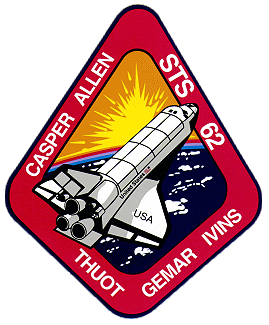 |
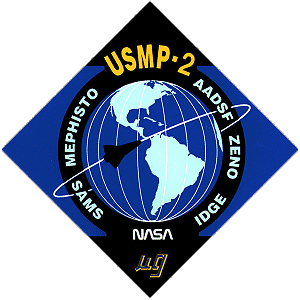 |
 |
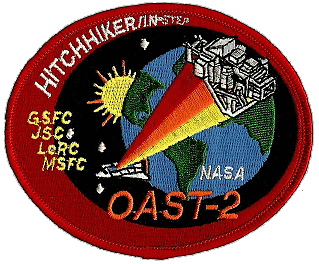 |
|
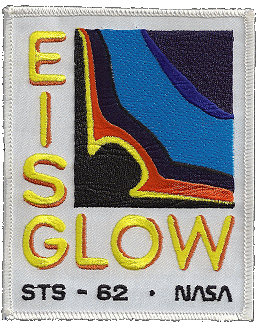 |
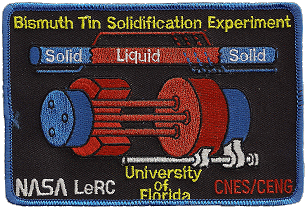 |
|
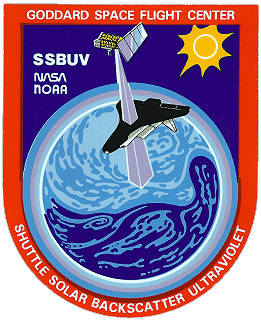 |
||
![]()
Launch, orbit and landing data
walkout photo |
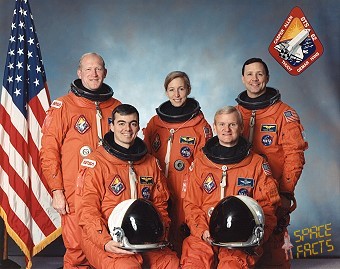 |
||||||||||||||||||||||||||||
alternative crew photo |
Crew
| No. | Surname | Given names | Position | Flight No. | Duration | Orbits | |
| 1 | Casper | John Howard | CDR | 3 | 13d 23h 16m 40s | 224 | |
| 2 | Allen | Andrew Michael "Andy" | PLT | 2 | 13d 23h 16m 40s | 224 | |
| 3 | Thuot | Pierre Joseph | MS-1, EV-1 | 3 | 13d 23h 16m 40s | 224 | |
| 4 | Gemar | Charles Donald "Sam" | MS-2, EV-2, FE | 3 | 13d 23h 16m 40s | 224 | |
| 5 | Ivins | Marsha Sue | MS-3, RMS | 3 | 13d 23h 16m 40s | 224 |
Crew seating arrangement
|
 |
|
||||||||||||||||||||||||
Hardware
| Orbiter : | OV-102 (16.) |
| SSME (1 / 2 / 3): | 2031 (10.) / 2109 (12.) / 2029 (9.) |
| SRB: | BI-064 / RSRM 36KM |
| ET: | ET-62 (LWT-55) |
| OMS Pod: | Left Pod 05 (5.) / Right Pod 05 (5.) |
| FWD RCS Pod: | FRC 2 (16.) |
| RMS: | 301 (12.) |
| EMU: | EMU No. 2033 (PLSS No. 1005) / EMU No. 2032 (PLSS No. 1003) |
Flight
|
Launch from Cape Canaveral (KSC) and
landing on Cape Canaveral (KSC), Runway 33. Due to a bad weather forecast the managers decided on March 02, 1994 to delay the launch for 24 hours. So, the external tank was not filled at this time and NASA saved 400,000 dollars. The primary payloads were the USMP-02 microgravity experiments package and the OAST-2 engineering and technology payload, both in the orbiter's cargo bay. The two-week mission also featured a number of biomedical experiments focusing on the effects of long duration spaceflight. The United States Microgravity Payload-2 (USMP-2) was the second in a series of missions to study the effects of microgravity on materials and fundamental sciences. USMP microgravity experiments were designed to be accomplished in the Space Shuttle payload bay. The USMP-2 mission consisted of five experiments. The Advanced Automated Directional Solidification Furnace (AADSF) studied the directional solidification of semiconductor materials in microgravity. The Critical Fluid Light Scattering Experiment (also called Zeno) measured the fluctuations of the density of xenon very near its liquid/vapor "critical point." The critical point occurs at a condition of temperature and pressure where a fluid is simultaneously a gas and a liquid with the same density. The Isothermal Dendritic Growth Experiment (IDGE) was designed to test theories concerning the effect of gravity-driven fluid flows on dendritic solidification of molten materials. Materials for the Study of Interesting Phenomena of Solidification on Earth and in Orbit (MEPHISTO) used several simultaneous measurement techniques in reduced gravity to investigate the precise nature of solidification. The objective of the Space Acceleration Measurement System (SAMS) was to measure the components of the microgravity environment on the USMP carrier in support of the major experiments and to provide data for orbiter dynamic analysis studies. One experiment on USMP-02 was the Isothermal Dendritic Growth Experiment (IDGE). That experiment continued to assemble data to test theories concerning the effect of gravity-driven fluid flows on dendritic solidification of molten materials. The Critical Fluid Light Scattering Experiment, or ZENO, science team reported that they expect to locate the critical temperature of xenon at "any time". Team members closely watched computer data traces which indicate their experiment was very near the critical temperature - the goal of a lengthy, methodical "sensitive" search process. This is a more precise search for the critical temperature after its location has been determined within a narrow band. Once the temperature is located, the team will spend nearly 24 hours taking a good look at the phenomenon they've waited years to see. They will study the properties of xenon at its critical point, taking subtle optical measurements in the region surrounding it. A fluid's "critical point" occurs at a condition of temperature and pressure where the fluid is simultaneously a gas and a liquid. By understanding how matter behaves at the critical point, scientists hope to gain a better insight into a variety of physics problems ranging from phase changes in fluids to changes in the composition and magnetic properties of solids. The Space Acceleration Measurement System (SAMS) continued to measure the microgravity environment on the USMP-2 carrier in support of the four other experiments on board. The SAMS team began sending results of their data collection during various orbiter activities to STS-62 crew members. The crew was interested in how they can minimize their influence on the microgravity environment. Measurements are made with the system at specific times when microgravity disturbances may be caused by events such as crew exercise and movement of the Shuttle's Ku-band antenna. Such observations also collect "signatures" which the team will be able to easily identify in future data. A related system, the Orbital Acceleration Research Experiment (OARE), is managed by NASA's Johnson Space Center. It is useful on missions such as USMP-2 where it is important to accurately characterize a wide variety of disturbances in the microgravity environment. Working closely with SAMS, the OARE records any low-frequency activity such as the Shuttle's friction with the rarefied upper atmosphere. SAMS is most suitable for recording higher-frequency activity such as crew exercise. The OARE instrument continues to process data in support of the USMP-2 experiments, and team members say all is going well. The Isothermal Dendritic Growth Experiment (IDGE) continued to assemble data to test theories concerning the effect of gravity-driven fluid flows on dendritic solidification of molten materials. When the USMP-2 mission is over, the IDGE team will study hundreds of photographs taken of the dendrites grown in microgravity. Learning more about how dendrites grow is one valuable key to developing better metal products and improving our industrial competitiveness. The Advanced Automated Directional Solidification Furnace (AADSF) studies the directional solidification of semiconductor materials in microgravity. Downlinked experiment data indicates that solidification of a crystal of mercury cadmium telluride is taking place, and the AADSF science team is constantly monitoring this slow but steady progress. Testing the AADSF in microgravity is beneficial because on Earth, gravity causes fluids to rise or fall within the melted portion; a warm liquid is less dense than a cool one and will rise to the top of the melt. These convective movements of molten material contribute to physical flaws in the internal structure of the growing crystal. Such flaws affect a crystal's overall electrical characteristics, and consequently, its usefulness in electronic devices. The MEPHISTO team reported that they have gathered good data with their directional solidification furnace. Currently, however, the team is still troubleshooting a problem discovered on Saturday night with a troublesome "Seebeck measurement". This electronic signal measures changes in the microstructure of a solidifying metal, and is conducted on one of three experiment samples of bismuth-tin. Other measurement techniques will be used on the two remaining samples later in the mission; both these samples are operating nominally. Measurement data from the three samples will give scientists insight into the precise nature of solidification in reduced gravity. OAST-2 contained six experiments on the field of technology for the space station, satellites, sensors and more. The overall objective of this payload was to obtain technology data to support future needs for advanced satellites, sensors, microcircuits and the international space station. The six experiments and their overall mission objectives were: Solar Array Module Plasma Interaction Experiment (SAMPIE) - Determine the arcing and current collection behavior of different types, sizes and shapes of solar cells, solar modules and spacecraft materials. The Solar Array Module Plasma Interaction Experiment (SAMPIE) investigated the plasma interactions of high voltage space power systems with the space plasma in low Earth orbit (LEO). Thermal Energy Storage (TES) - Determine the microgravity behavior of two different thermal energy storage salts that undergo repeated melting and freezing. The Thermal Energy Storage (TES) experiments were designed to provide data about the microgravity behavior of thermal energy storage salts which undergo repeated freezing and melting. This type of data has never been obtained before and has a direct impact on the development of on-orbit energy storage systems. Experimental Investigation of Spacecraft Glow (EISG) and Spacecraft Kinetic Infrared Test (SKIRT) - Develop an understanding of the physical processes leading to the spacecraft glow phenomena by studying infrared, visible and far-ultraviolet light emissions as a function of surface temperature and orbital altitude. The Experimental Investigation of Spacecraft Glow (EISG) and Spacecraft Kinetic Infrared Test (SKIRT) experiments investigated the phenomenon known as spacecraft glow. This is an aura of light created around the leading or front-facing surfaces of all spacecraft as they orbit Earth. Oxygen and nitrogen form molecules in excited states when the spacecraft rams into them at high velocity. Emulsion Chamber Technology (ECT) - Measure background cosmic ray radiation as a function of shielding and radiation energy photographic films. The Emulsion Chamber Technology (ECT) experiment tested the sensitivity of photographic materials, used as detectors for cosmic ray analysis, to deterioration effects from heat, mechanical vibration and unwanted background radiation. Cryogenic Two Phase (CRYOTP) - Determine the performance of microgravity nitrogen space heat pipe and cryogenically-cooled, vibration-free, phase-change-material thermal storage unit thermal energy control technologies. The Cryogenic Two Phase (CRYOTP) experiment was investigating the use of very cold liquids - cryogens - for the purpose of heat dissipation. Heat pipes are being tested as possible solutions to thermal control problems. The heat pipe is a very efficient heat transfer device commonly used for cooling electronic components and sensors. A heat pipe is essentially a closed, evacuated tube that contains a porous structure, called a wick, and a small quantity of liquid, called the working fluid. STS-62 was the sixth Space Shuttle flight of the Shuttle Solar Backscatter Ultraviolet (SSBUV) Instrument, a highly calibrated instrument that can be used to check data from ozone-measuring instruments on freeflying satellites. Data from SSBUV were compared to observations from instruments on NASA's Total Ozone Mapping Spectrometer (TOMS) and Upper Atmosphere Research Satellite (UARS), and the National Oceanic and Atmospheric Administration NOAA-9 and NOAA-11 satellites. Calibration of these data sets ensures the most accurate readings possible for the detection of atmospheric ozone trends. SSBUV and the NOAA SBUV instruments estimated the amount and height distribution of ozone in the upper atmosphere by measuring incoming solar ultraviolet radiation and ultraviolet radiation reflected or scattered back from the Earth's atmosphere. Because ozone absorbs ultraviolet energy, the difference in these measurements can be used to derive ozone levels in the atmosphere. The five previous SSBUV flights occurred on STS-34 in October 1989, STS-41 in October 1990, STS-43 in August 1991, STS-45/ATLAS in March 1992 and STS-56/ATLAS-2 in April 1993. Powerful electromagnets, generating an attraction force of 3,200 pounds (1,451 kg), will be used to grapple objects with the robot arm in Columbia's payload bay during a flight demonstration of the Dexterous End Effector (DEE). The new end effector and grapple fixture design will increase the arm's dexterity and alignment accuracy, provide operators with a sense of touch and allow the use of more compact "handles" on satellites and payloads. During the test, three STS-62 crew members took turns operating and observing the remote manipulator system (RMS) in a series of 1-hour sessions, each involving approximately eight tasks, for a total of about 24 hours. The tasks were involved aligning the arm with targets, grappling a test probe, inserting the test probe into receptacles of progressively smaller clearances and applying force and torque to the probe with the arm. DEE incorporated a magnetic end effector (MEE), a targeting and reflective alignment concept (TRAC) camera system and a carrier latch assembly (CLA). MEE used two U-shaped electromagnets to grab and release payloads fitted with a flat, ferrous grapple fixture or "handle." MEE provided a reliable method of maintaining a good grip on the payload and a safer, more reliable method for releasing it in the event of an RMS or orbiter failure. TRAC provided a simpler, faster, more intuitive grapple alignment targeting system and could be used manually or automatically. It allowed for the precise alignment of two objects using a video system and a mirrored target. In essence, the operator looked through a camera that points outward from the center of DEE at the target until the camera can see its own reflection, then finishes the process by lining up a set of cross hairs. The Limited Duration Space Candidate Materials Exposure (LDCE) flight series used small cargo bay payload accommodations to evaluate materials being considered for use in space structures. The STS-62 LDCE activities exposed three identical sets of materials to the space environment. Each set was comprised of 264 samples mounted in its own container, the lid of which opened mechanically to expose the samples. The containers were positioned such that when open, the samples face directly up and out of the payload bay. One container was opened soon after reaching orbit and was left open until preparations for orbiter reentry. A second container was handled the same way except that its lid was returned to the closed position during mission segments when the cargo bay was facing the direction of orbital motion (the "ram" direction). The third container was opened only during those times that the cargo bay is facing the ram direction. Proteins are vital to all life, playing roles from providing nourishment to fighting disease. Since 1985, Protein Crystal Growth (PCG) experiments aboard the Space Shuttle have been helping scientists determine the complex molecular structures of important proteins. The PCG experiment hardware for STS-62 incorporates several improvements based on experience from past Shuttle flights. Two different experiments on STS-62 used the vapor diffusion technique to grow protein crystals in space. One of the two techniques was the improved version of the vapor diffusion apparatus used on previous flights. The other was a flight test of off-the-shelf crystallization chambers commonly used in Earth-based labs. The Commercial Protein Crystal Growth (CPCG) payload was located in the Shuttle middeck and used the space required for up to two standard middeck lockers. It has been shown that the weightlessness of spaceflight provides an excellent environment for improving the quality of protein crystals, which can be used in medical and scientific research. It is expected that the techniques developed by CMC will become the basis for commercially viable endeavors with significant benefit to the U.S. economy, along with providing dramatic advances in medicine and other scientific activities. The Middeck 0-Gravity Dynamics Experiment (MODE) was a reusable Space Shuttle middeck facility designed to study the nonlinear, gravity-dependent behavior of two types of space hardware - contained fluids and large space structures - planned for future spacecraft. MODE was classified as a complex secondary payload and occupies 4 middeck lockers. The experiment required less than 115 watts to operate. MODE was first flown on STS-48 (Discovery, September 1991) where two separate fluids and structures experiments were combined into a single mission to take advantage of the commonality in the required electronics. In 18 hours of on-orbit operation, the MODE hardware performed flawlessly and returned more than 600 megabytes of high-quality data on the nonlinear behavior of fluids and truss structures in the microgravity environment of the Shuttle middeck. MODE/STS-62 performed an extensive array of tests on various configurations of the MODE Structural Test Article (STA) to expand on the structural dynamics results of the STS-48 mission. The Extended Duration Orbiter (EDO) Medical Project was designed to assess the impact of long-duration spaceflight, 10 or more days, on astronaut health; identify any operational medical concerns and test countermeasures for the adverse effects of weightlessness on human physiology. For the STS-62 mission, the Medical Sciences Division of the Johnson Space Center, Houston, was sponsoring 11 DSOs that support the project. All of the studies have been flown on previous Shuttle missions. The Biotechnology Specimen Temperature Controller (BSTC) experiment on STS-62 was the first phase of a series of four development tests that will fly on upcoming Shuttle missions to assist in development of the Bioreactor, a cell-culture growth device under development at the Johnson Space Center. The BSTC tested the performance of a temperature control device being developed for use with the Bioreactor. Proper control of temperature is a critical element of cell culture growth. The BSTC experiment did not include a prototype Bioreactor onboard. It was a test of a heating device that may be used with the Bioreactor and the experiment took one middeck locker onboard Columbia. Colon carcinoma cells completely sealed in cellculture chambers were loaded into the unit prior to launch. The only crew interaction required was to turn the temperature controller on the outside of the experiment to 35 degrees Centigrade after reaching orbit. Following landing, the cell cultures were removed by ground personnel and the specimens studied to evaluate the operation of the temperature controller. The primary objective of Physiological Systems Experiment-04 (PSE-04) was to study the complex interrelationship between the immune and skeletal systems during exposure to microgravity. Previous NASA and Center for Cell Research flight experiments have demonstrated that microgravity exposure rapidly impairs musculo-skeletal and immune system functions simultaneously. The simultaneous impairment of these two systems also occurs in some disease states on Earth and indicates that the physiological controls of the two systems may be linked. To test the linkage hypothesis, a pharmaceutic that has the capacity to modulate both bone and immune cell function was administered to 12 adult female rats prior to spaceflight. The Commercial Generic Bioprocessing Apparatus supported more than 15 commercial life science investigations that have application in biomaterials, biotechnology, medicine and agriculture. Investigations have been selected on the basis of commercial potential and ability to take advantage of the extended orbit time on this flight. Each experiment sample was contained in a custom designed test tube called the Fluids Processing Apparatus (FPA). Each FPA typically contained three separate fluids that could be mixed sequentially on orbit by depressing a plunger mechanism. Generally, the first two fluids were mixed early in the mission. The Air Force Maui Optical Site (AMOS) tests allowed ground- based electro-optical sensors located on Mt. Haleakala, Maui, Hawaii, to collect imagery and signature data of the orbiter during cooperative overflights. The scientific observations made of the orbiter, while performing reaction control system thruster firings, water dumps or payload bay light activation or the phenomena of "Shuttle glow", a well-documented fluorescent effect created as the Shuttle interacts with atomic oxygen in Earth orbit, and were used to support the calibration of the AMOS sensors and the validation of spacecraft contamination models. The AMOS tests had no payload unique flight hardware and only required that the orbiter be in predefined attitude operations and lighting conditions. |
Photos / Graphics
 |
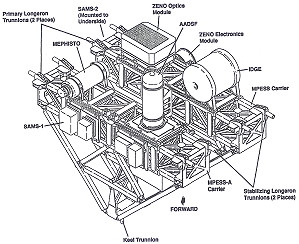 |
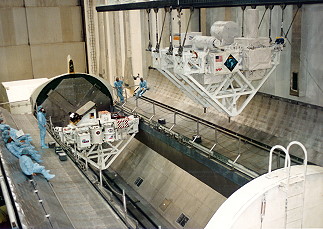 |
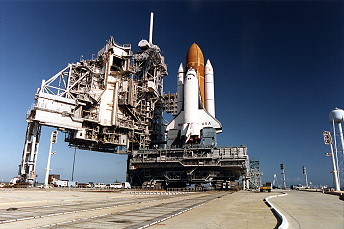 |
 |
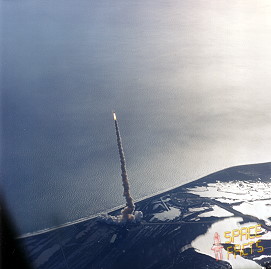 |
 |
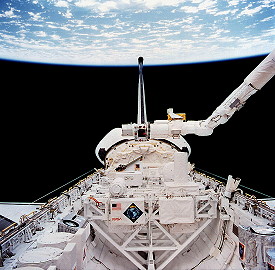 |
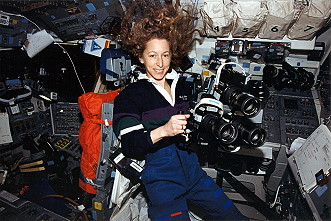 |
 |
 |
 |
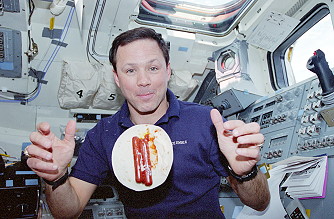 |
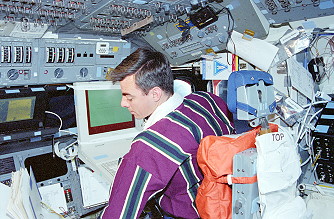 |
 |
 |
more Earth observation photos |
|
| © |  |
Last update on March 29, 2021.  |
 |